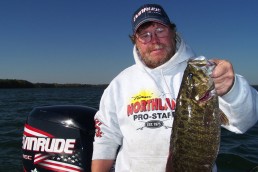Rattle, Flutter and Swibaits can Call in Walleyes
SHARE THIS POST
Over the past decade, aggressive search tactics for walleye have been trending across many fisheries, particularly large bodies of water where the sheer acreage can be daunting. Lures, combined with mobility, allow anglers to cover more water. Rattle baits, flutter spoons and swim lures can all be effective for locating the walleyes.
One key element of breaking down water and finding these fish through the ice is making sure that they can also find you. An aggressive style isn’t just snapping or ripping a lure to trip a reaction from a fish, which sometimes happens. But you want to increase the amount of water you can cover because fish will see you and react from areas that are farther away. A high lift with a flutter spoon for example might pull fish in from 20 feet away or more, and a hard pound with a rattle spoon might create enough noise, flash and water displacement to pull a fish in from several feet away like ringing a dinner bell.
There is a difference between finding the fish and catching them. Typically, the methodology of covering water and eliminating dead water to find them is a matter of sampling as much water as possible. Some of the first walleyes you pull off a spot can sometimes be the most aggressive if you are fishing through the ice. As you pull a few fish off the location, they typically get less aggressive. The longer you wear out your welcome on a spot, the harder the fish get to catch. This decline in productivity often aligns with less competition. And when fish are competing against each other to eat, these fish can make you look good.
Fishing pressure plays a huge role in how fish react to you. Many of these aggressive search and destroy tactics have originated and have helped anglers excel on larger bodies of water because they allow you to stray away from the fishing pressure and allow you to find your own fish.
As you move from search mode to catch mode, we are typically forced to make a lot of adjustments. These could be as simple as adapting to a fish on the screen. But when we are not marking fish, we are playing the lure so that we can hopefully reach a distant fish. When a fish shows up, we often have to change the cadence to trigger them and their bite. Knowing when to change up your cadence and how to react when they are on the Vexilar separates great anglers from average.
Are you enjoying this post?
You can be among the first to get the latest info on where to go, what to use and how to use it!
As walleyes come in on the presentation, they can stall out as they reach a lure. If a fish lunges at the bait and misses or if it overshoots a lure or the presentation falls behind a stalled fish, the lure may disappear. This is the worst thing when trying to trigger a fish. These fish basically drift off swimming away from the lure unless they turn around. When the mood is mediocre, you don’t get to screw things up; you get one chance. When a fish comes in hot and then just disappears, often, it simply overshot the lure and missed. The best way to turn one around is to raise the lure and pound it hard enough to where they can feel it. Cadences have to be aggressive, but done in a tight window.
Higher lifts create a lot of flash and can be seen from a distance, but they also create a risk of swinging out and falling behind the face of a fish when they do get closer. Usually, lifting a spoon up 4 feet and dropping it down fast is not a good move when there’s a fish on top of you. The triggering moves become tighter and you want to keep that lure in front of the fish, and not disappear. Many anglers at this point don’t do enough, and then the fish don’t react to the lure. Most of the time we have to keep the lure moving.
One of the most common mistakes many make when attempting to trigger a walleye with a lure is letting the lure settle too much between strokes. Imagine a jig stroke and then the lure settles to the bottom of the stroke and hangs. The longer it hangs, the more the lure turns. On the next stroke, the lure comes off a different direction, and this direction is unpredictable. One second the lure is 6 inches in front of the fish and then the lure shoots toward the fish, disappearing—game over.
Here’s a little secret that will help you catch more walleyes: don’t let a lure settle at the bottom of the jig stroke. Start your upstroke before the lure settles so that the lure dances and the cadence and direction of the dart or swing become locked into one direction and becomes predictable. The target becomes much easier for fish to hit.
Remember, walleyes don’t back up that well and they need room to turn around, and this is why staying in front of them is crucial. This is perhaps the most important reason for changing the cadence and adjusting a lure as fish close the distance. And, this is why finding fish can be different than catching them. Again, those moves that pull fish into the cone angle from 20 feet away often have to change as fish get closer—this understanding of how to use tempo and cadence to find fish while reading your electronics to adapt and trigger them will help you catch more walleyes the remainder of this winter.
MWO
SHARE THIS POST
Did you enjoy this post?
You can be among the first to get the latest info on where to go, what to use and how to use it!
Jason Mitchell
Jason Mitchell was a top walleye guide on Devils Lake, N.D. for nearly 20 years. Today, Mitchell produces the Jason Mitchell Outdoors TV program. Visit jasonmitchelloutdoors.com for more.



